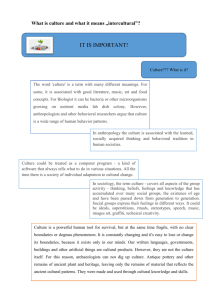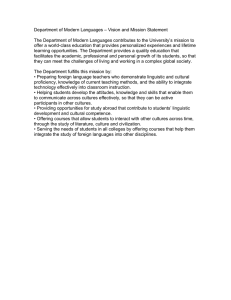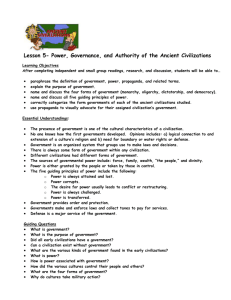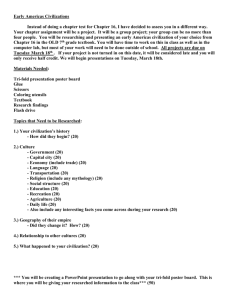Document 13302483
advertisement
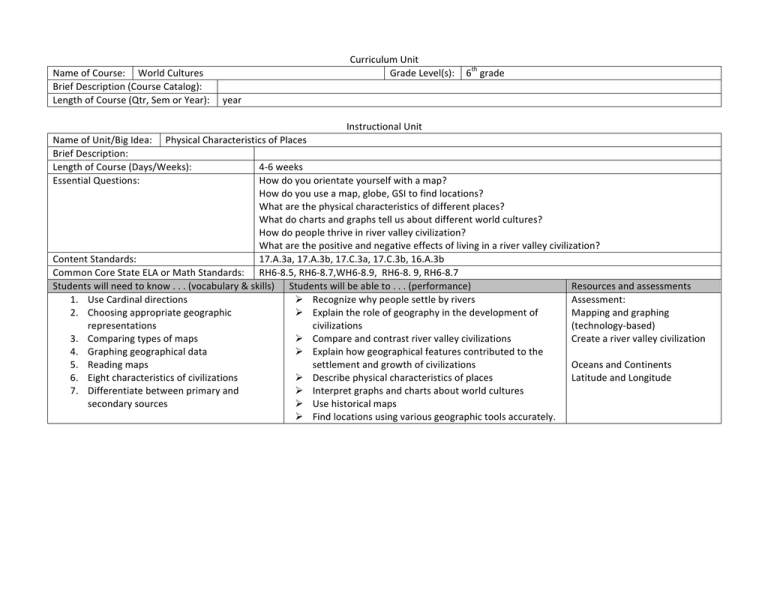
Name of Course: World Cultures Brief Description (Course Catalog): Length of Course (Qtr, Sem or Year): Curriculum Unit Grade Level(s): 6th grade year Instructional Unit Name of Unit/Big Idea: Physical Characteristics of Places Brief Description: Length of Course (Days/Weeks): 4-­‐6 weeks Essential Questions: How do you orientate yourself with a map? How do you use a map, globe, GSI to find locations? What are the physical characteristics of different places? What do charts and graphs tell us about different world cultures? How do people thrive in river valley civilization? What are the positive and negative effects of living in a river valley civilization? Content Standards: 17.A.3a, 17.A.3b, 17.C.3a, 17.C.3b, 16.A.3b Common Core State ELA or Math Standards: RH6-­‐8.5, RH6-­‐8.7,WH6-­‐8.9, RH6-­‐8. 9, RH6-­‐8.7 Students will need to know . . . (vocabulary & skills) Students will be able to . . . (performance) Resources and assessments 1. Use Cardinal directions Ø Recognize why people settle by rivers Assessment: 2. Choosing appropriate geographic Ø Explain the role of geography in the development of Mapping and graphing representations civilizations (technology-­‐based) 3. Comparing types of maps Ø Compare and contrast river valley civilizations Create a river valley civilization 4. Graphing geographical data Ø Explain how geographical features contributed to the 5. Reading maps settlement and growth of civilizations Oceans and Continents 6. Eight characteristics of civilizations Ø Describe physical characteristics of places Latitude and Longitude 7. Differentiate between primary and Ø Interpret graphs and charts about world cultures secondary sources Ø Use historical maps Ø Find locations using various geographic tools accurately. Instructional Unit Name of Unit/Big Idea: Traditions Brief Description: Length of Course (Days/Weeks): Essential Questions: Cultures and religion 10-­‐12 weeks How do empires affect culture? What defines culture? How do cultures communicate? What purpose does religion serve? How do traditions promote or reflect values? Content Standards: 18.A.3, 18.B.3a, 18.B.3b, 18.C.3b Common Core State ELA or Math Standards: RH6-­‐8. 9, WH6-­‐8.2, Students will need to know . . . Students will be able to . . . (performance) (vocabulary & skills) 1. Organization of notes • Identify geographical features along trade routes 2. Information writing o Benefits of trading 3. Compare/Contrast Sources • Compare information on populations of the Fertile Crescent and Nile 4. Using artifacts River Valley civilizations • Define culture o Analyze images of culture o Analyze how a human culture evolves o Synthesize information to form an opinion and make observations about culture. • Describe an Empire and how it is built o Wars o Expansion • Explain the purpose of religion o Role of religion o Roles of Gods/Goddesses o Define polytheism and monotheism o Differentiate between religions in India and China o Compare and contrast Hinduism and Buddhism • Explain how traditions promote and reflect values o Apply a Chinese philosophy to a real world situation and predict its effects o Describe ancient Greek philosophy o Compare Ancient and modern Greek beliefs Resources and assessments • Video intro clip • Population video/interactive timeline Common Assessment: If you were dropped into an ancient civilization what would you need to know to survive on a day to day basis? • Ancient Civilization newscast Explain the difference in Sparta and Athens Explain how art, music, and architecture reflects to traditions and values o Explain what technological advances were made to help further development civilization and culture Explain how cultures communicate o Compare communication styles in different cultures Relate past to present o o • • Instructional Unit (2014-­‐2015 school year move government prior to traditions) Name of Unit/Big Idea: Government Brief Description: Length of Course (Days/Weeks): Essential Questions: 4-­‐6 weeks 1. How do people change their government? 2. How does government affect one’s culture? 3. What are the advantages and disadvantages of government? Content Standards: 16.B.3a, 14.C.3 Common Core State ELA or Math Standards: RH6-­‐8.3, RH6-­‐8.4 Students will need to know . . . Students will be able to . . . (performance) Resources and assessments (vocabulary & skills) 1. Oral presentation Common Assessment: • Anarchy – reasons for government 2. Compare/Contrast • Summarize important facts about the rights, responsibilities, and duties • 60-­‐second persuasive 3. Identify ways to make presentation on one form of of US citizens differences in the government o Connections to current events community • Group debate based upon • Foundations of government presentations – compare and o Origins contrast forms of government o Limited o Unlimited • Government Test • Types of government o Monarchy (Code of Hammurabi, 7 Kings, Pharaoh) o Emperors (Shi Huangdi, Alexander the Great) o Oligarchy o Tyranny/dictatorship o Representative democracy o Direct democracy o Republic • Identify similarities and differences between the rights and responsibilities of ancient citizens and US citizens today • Explain the advantages and disadvantages between Athenian democracy and American democracy • Give examples of how people change their government • Explain how governments affect the culture • Compare and contrast the qualities of a great military leader and an effective ruler. Instructional Unit Name of Unit/Big Idea: Social Mobility Brief Description: Length of Course (Days/Weeks): Essential Questions: 3-­‐4 weeks 1. Why do social classes exist within cultures? 2. What defines movement within the social classes? 3. How do world cultures define gender and age treatment? Content Standards: 16.D.2, 17.C.3c, 17.D.3a, 18.B.3a Common Core State ELA or Math Standards: RH6-­‐8.2, RH6-­‐8.5, RH6-­‐8.8, RH6-­‐8.9 Students will need to know . . . (vocabulary & skills) Students will be able to . . . (performance) 1. Research Ø Describe ancient Egyptian social classes 2. Point of View/opposing point of view Ø Analyze life from the perspective of people in 3. Analyze primary resources different social classes Ø Compare and contrast social classes from various civilizations Ø Discuss how specialization of labor and commercialization impact social mobility Ø Compare and contrast how peoples are treated in different cultures Ø Compare how people can move into different social classes in different cultures Resources and assessments Assessment: Compare and Contrast writing Instructional Unit Name of Unit/Big Idea: Genocide Brief Description: Length of Course (Days/Weeks): Essential Questions: 3-­‐4 weeks 1. What are the roles in genocide? 2. Why do genocides occur? 3. What defines genocide? Content Standards: State mandate Common Core State ELA or Math Standards: RH6-­‐8.9, RH6-­‐8.4, RH6-­‐8.8 Students will need to know . . . (vocabulary & skills) Students will be able to . . . (performance) 1. Evaluate information from media Ø Use maps to identify key locations of genocides 2. Identify bias Ø Discuss individual and institutional responsibilities 3. Make generalizations from primary and in genocide secondary sources Ø Explain why genocides occur Ø Define genocide Ø Give examples of genocides o Ukraine o Rwanda o Sudan o Armenia o Cambodia Resources and assessments Novel: Long Walk to Water Assessment: Create a Wiki blog




